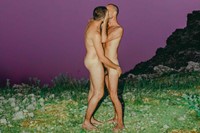Night Fever: Film and Photography After Dark explores the myriad ways nighttime is represented in the mediums
In 1969, the American photographer William Gedney arrived in Benares, India on a Fulbright scholarship. During nighttime walks he began taking, he captured his new surroundings in black-and-white images opaque with a sense of mystery and estrangement. Yet the same opacity had confronted the photographer in his nocturnal images of coal mining communities and hippies back home. “No one is familiar with the night,” he wrote.
Gedney’s quote is a guiding star in Night Fever: Film and Photography After Dark, a recently launched book exploring how the mediums of film and photography represent the nighttime. The publication is edited by Shanay Jhaveri, the head of visual arts at the Barbican, who was interested in how, for lens-based media, writing on the nighttime was generally limited to mechanics over thematics. “It’s focused on the technical facets of how you shoot at night, but it hasn’t delved beyond into the actual relationship between the medium and the night as a space for reflection and contemplation,” he explains.
Featuring 20 photographer portfolios and texts by over 40 scholars, critics and curators, the result a deep and sensuous book that explores how the nighttime allows us to “rejoice and rebel, but also to seek rest, refuge and perhaps some revelation,” as Jhaveri writes in the introduction. Yet Night Fever is also acutely aware of how photography and film (as light-based media) have a paradoxical relationship with the dark. In her series Dream Villa, photographer Dayanita Singh explores the limits of colour photography at night. Devoid of humans, in her images of streets, trees and boats, the camera’s flash and saturation creates disquieting, science fiction-inflected images.
In the essay that follows, Chris Fujiwara explores how 1960 marked a turning point for on-screen depictions of the night. From L’Avventura (1960) to La Dolce Vita (1960), insomniacs began to populate cinema, the immensity of night becoming cinema’s hottest set design. Night Fever deliberately selects all its works from the latter half of the 20th century, an era where post-war optimism mutated into neoliberalism and late capitalism – or “the ends of sleep”, as Jonathan Crary famously defines it in his 2013 polemic 24/7.

For a book about the nighttime, sleep – of the eight-hour, mattress kind – is largely absent from Night Fever. “Labour and work extend into the night in various registers,” says Jhaveri. “It’s a book about corporeal life being and moving through the night in various physical states – exhausted or not.” Genevieve Yu’s essay Night Work, explores the invisible labour of (gendered, raced) bodies while others sleep; David Goldblatt’s images depict the weary bodies of commuters during apartheid South Africa, their journeys starting as woozily early as 2am. Academic Elena Gorfinkel meanwhile, celebrates the cinema seat as the most perfect of pillows. “There is no better place to lose oneself than in the cinema’s night sky, that required darkness, the baseline condition for the medium’s operation.”
Fun is of course to be had: throughout the nighttime is also presented as a carnivalesque, a temporal window when social order can be upturned, for better and sometimes for worse. Kohei Yoshiyuki’s series The Park depicts cruising spots in Tokyo’s Shinjuku, Yoyogi, and Aoyama parks during the 1970s. Featuring formless figures in states of lustful intoxication, the book rotates them 90-degrees so we have to turn our heads, voyeuristically, to read them.

Curatorially, Night Fever jumps from timezone to timezone – it is always night somewhere, after all. “The brief for designers was to think about the book as an exploratory walk through the night,” says Jhaveri. “There isn’t a predetermined destination or a linear journey that one needs to follow.” While the book’s opening image – Myriam Boulos’ photograph of two men embracing in front of an unreal, purple sky – encapsulates many of the book’s themes (“sensuality, nature, desire and hedonism”), Night Fever can be entered and exited at any point. Move through it forwards and backwards, linger and flick through. Like the best night out, there’s no telling where you might end up.
Night Fever: Film and Photography After Dark is published by Koenig Books, and is out now.






